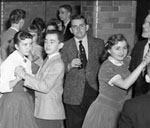A Hoax Provokes Folks: Why Lie?
Back to the beginning of the country, the American media has run stories that were widely regarded as true, but were eventually revealed as hoaxes. A few of them were innocuous. Some were not. Were the following hoaxes really printed?
1. March 12, 1782: Benjamin Franklin, in France during the Revolutionary War to make mischief for the British, composes and prints up a page of an imaginary newspaper, the Boston Independent Chronicle. The newspaper carries a letter supposedly from Captain Gerrish of the New England Militia that describes in detail a package of more than 1,000 dried scalps captured from Seneca Indians paid by the British to terrorize men, women, and children among the American colonists. The package was to be shipped to England for the gratified amusement of King George. In a letter to a friend, Franklin says of his story: "The Form may perhaps not be genuine, but the Substance is truth."
Yes
2. August 21, 1835: The New York Sun begins a series of articles describing Royal Astronomer Sir John Herschel's discoveries of sentient beings living on the Moon through a giant telescope. The ladies of Springfield, Massachusetts subscribe to a fund "to send missionaries to the benighted luminary."
Yes
3. April 13, 1844: The New York Sun publishes Edgar Allan Poe's (spurious) account of a crossing of the Atlantic Ocean by balloon. The demand for the paper is so great that crowds block the Sun office throughout the day waiting to buy copies, and Poe is unable to get a copy for himself.
Yes
4. September 1844: During James Polk's presidential campaign, the Whig-run Ithaca Chronicle publishes a letter, claiming to quote directly from a Baron von Roorback's Tour through the Western and Southern States in 1836, about a slave caravan. It includes a description of 40 slaves among the manacled purchased from Polk, whose initials had been branded into their shoulders. Thurlow Weed eagerly copies it into his Albany Evening Journal and it becomes a major issue in the campaign, until it is shown to be a hoax. The passage was created by doctoring a passage from Excursion Through the Slave States, written by George W. Featherstonhaugh and published in London in 1844.
Yes
5. October 4, 1862: Samuel Clemens, then a writer for the Virginia City, Nevada, Territorial Enterprise, publishes an article about the discovery of a sitting, petrified man in the mountains, of which "every limb and feature" was still perfect, except turned into stone. The story is widely believed and reprinted in other papers around the country.
Yes
6. March 2, 1864: Union cavalry officer Colonel Ulric Dahlgren leads a raid against Richmond, whose main purpose is to free prisoners of war being held by the Confederacy at Belle Isle. Dahlgren is shot and killed during the unsuccessful raid. Southern soldiers find documents on his body that outline other objectives of the raid, including orders for Dahlgren to burn and destroy the city and to kill Confederate President Jefferson Davis and his cabinet, actions clearly outside the conventional rules of war. The Richmond Examiner publishes the text of the documents and says in an enraged editorial that the North has decided to begin conducting the war "under the Black Flag."
Yes
7. May 18, 1864: The New York World and the New York Journal of Commerce print what they believe to be an Associated Press story about a proclamation from President Lincoln ordering a huge new conscription of soldiers. This causes speculators to sell stocks and buy gold on fear that the Civil War will continue far longer than was expected. It is quickly revealed that Joseph Howard, the city editor of the Brooklyn Eagle, forged the story so that he could buy gold before the story came out and sell it at the end of the day.
Yes
8. April 1, 1874: New York Herald reporter Joseph Clarke and editor Thomas Connery panic New Yorkers by publishing an article they have concocted about a mass escape of animals from the Central Park Zoo. In the story, animals roamed the city looking for prey of the species homo sapiens, causing "terrible scenes of mutilation." Cartoonist Thomas Nast later references the hoax in a political cartoon he draws for Harper's Magazine, in which he depicts the Democrats as an ass and the Republicans as an elephant, creating the parties' political icons.
Yes
9. August 16, 1924: During Prohibition, New York Herald reporter Sanford Jarrell publishes a story about a "mysterious joy-boat of 15,000 tons which was lying about 15 miles off Fire Island, aboard which Long Island millionaires and pretty playthings of the idle rich were drinking intoxicating beverages and disporting themselves with the utmost abandon by night." The day after the article is published, the Coast Guard is assigned to hunt down the vessel. When the Herald editors discover the story is a hoax, they fire Jarrell.
Yes
10. November 20, 1967: U.S. News and World Report claims that it can confirm the authenticity of The Report from Iron Mountain, a book recently published by Dial Press. The book purported to be the text of a leaked report issued by a secret study group commissioned by the Johnson Administration. The group concluded that a lasting peace, if it were ever achieved, would not be in the best economic interests of society, and that the government should foster a war mentality by scaring people with exaggerated threats of terrestrial, and even extraterrestrial, foes and impending environmental disasters. It also recommended that the government heighten inter-ethnic tensions within the country and even re-institute slavery. Author Leonard Lewis confessed in 1972 that he wrote the book, but defended it as a useful stimulus to public debate on the Vietnam War. Lewis claimed that the 1971 leaked publication of the "Pentagon Papers," which were real, demonstrated that the government is capable of actions that are as outrageous as anything in his "satire."
Yes
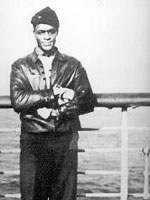

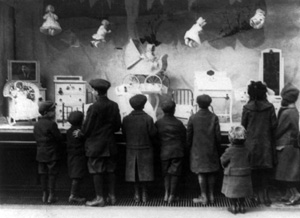












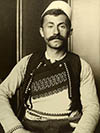

 a pushcart ice cream vendor in New York, in 1896, who also, perhaps, invented the ice cream sandwich by putting a slice of ice cream between waffle squares cut from a sheet. Other sources say the ice cream cone has its origins in the mists of history, but was first described in Mrs. Marshall's Cookery Book, whose author, Agnes Marshall, published it in London in 1888. Still others discern a woman licking an ice cream cone in an 1807 picturing fashionable customers eating at the Frascati café in Paris, although this is uncertain because cone-shaped ice cream bowls were not unknown at the time.
a pushcart ice cream vendor in New York, in 1896, who also, perhaps, invented the ice cream sandwich by putting a slice of ice cream between waffle squares cut from a sheet. Other sources say the ice cream cone has its origins in the mists of history, but was first described in Mrs. Marshall's Cookery Book, whose author, Agnes Marshall, published it in London in 1888. Still others discern a woman licking an ice cream cone in an 1807 picturing fashionable customers eating at the Frascati café in Paris, although this is uncertain because cone-shaped ice cream bowls were not unknown at the time.
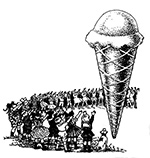
 Mother's Day—as celebrated now in America and in many places abroad—is largely the result of the efforts of a West Virginia woman named Anna Jarvis. In 1908, Jarvis wanted to commemorate her recently deceased mother's own attempt to establish a day in which to honor women.
Mother's Day—as celebrated now in America and in many places abroad—is largely the result of the efforts of a West Virginia woman named Anna Jarvis. In 1908, Jarvis wanted to commemorate her recently deceased mother's own attempt to establish a day in which to honor women.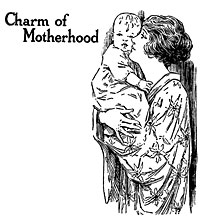
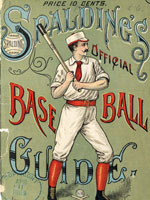

 1. a. Mass Plays, such as the "flying wedge" pictured here (invented in 1892 by a Harvard fan), were tremendously brutal and were soon outlawed. The rules were changed in 1894 so that no more than 2 players could go in motion before the start of the play. Also, the ball carrier's teammates were forbidden to push or pull him.
1. a. Mass Plays, such as the "flying wedge" pictured here (invented in 1892 by a Harvard fan), were tremendously brutal and were soon outlawed. The rules were changed in 1894 so that no more than 2 players could go in motion before the start of the play. Also, the ball carrier's teammates were forbidden to push or pull him.  2. b. For a long time, goals scored more points than touchdowns. Touchdowns were more valuable as a means of getting a favorable placement for an unimpeded try at kicking a field goal. The defense would play in order to prevent a goal rather than defending against a touchdown, making the "dribble" a possible offensive strategy until it was made illegal in 1887. Note that the player holding the ball for the kicker (lying on the ground) in the illustration here had to keep the ball off the ground as the kicker prepared himself because as soon as the ball touched the ground, it was in play.
2. b. For a long time, goals scored more points than touchdowns. Touchdowns were more valuable as a means of getting a favorable placement for an unimpeded try at kicking a field goal. The defense would play in order to prevent a goal rather than defending against a touchdown, making the "dribble" a possible offensive strategy until it was made illegal in 1887. Note that the player holding the ball for the kicker (lying on the ground) in the illustration here had to keep the ball off the ground as the kicker prepared himself because as soon as the ball touched the ground, it was in play.  3. b. This method of putting the ball in play (known as a "fair," as opposed to the play known as a "fair catch," described in the other possible answer), proved too unruly and prone to "slugging" as the players massed together near the sideline. It was eliminated by requiring the referee to bring the ball out from the sideline and place it in the middle of the field.
3. b. This method of putting the ball in play (known as a "fair," as opposed to the play known as a "fair catch," described in the other possible answer), proved too unruly and prone to "slugging" as the players massed together near the sideline. It was eliminated by requiring the referee to bring the ball out from the sideline and place it in the middle of the field. 4. True. When tackling below the waist down to the knees was allowed in 1888, the defense was strengthened and the offense therefore needed to be bolstered by the rules to keep the game balanced. To do this, the teammates of the ball carrier were allowed to "interfere" with (that is, move and block) the opposing team with their bodies (but not their hands and arms—note the illegal use of hands by the blockers in the picture) even after the ball had been snapped. Because these offensive players were in front of the ball after it had been snapped, any movement by them had previously been disallowed as "offsides play." The rule meant that the ball carrier could now run behind his teammates (who would block for him), and not (as in rugby) in front of them, ready to pass the ball back when he was about to be tackled.
4. True. When tackling below the waist down to the knees was allowed in 1888, the defense was strengthened and the offense therefore needed to be bolstered by the rules to keep the game balanced. To do this, the teammates of the ball carrier were allowed to "interfere" with (that is, move and block) the opposing team with their bodies (but not their hands and arms—note the illegal use of hands by the blockers in the picture) even after the ball had been snapped. Because these offensive players were in front of the ball after it had been snapped, any movement by them had previously been disallowed as "offsides play." The rule meant that the ball carrier could now run behind his teammates (who would block for him), and not (as in rugby) in front of them, ready to pass the ball back when he was about to be tackled. 5. True. The forward pass was not legal until 1906. Until then, a "pass" always meant the ball carrier's passing backwards. The extensive 1906 rule changes aimed to reduce violence and injury on the field, which had become pronounced, especially in the clash at the line of scrimmage. The changes were meant to "open up" the play. Most notable among the changes was the increase in the number of yards the offense had to advance in a series of downs from 5 to 10, and the allowing of forward passes, which was meant to spread out the players more. Oddly, many football pundits, when the rule was changed and for some time afterwards, did not think the forward pass would be popular. This was partly because, at first, the new rule stipulated that if the pass was incomplete, the ball had to be turned over to the opposing side, and partly because no one had figured out how to throw an effective, spiraled forward pass. The shape of the ball then evolved to make passes easier, becoming a little smaller and more pointed.
5. True. The forward pass was not legal until 1906. Until then, a "pass" always meant the ball carrier's passing backwards. The extensive 1906 rule changes aimed to reduce violence and injury on the field, which had become pronounced, especially in the clash at the line of scrimmage. The changes were meant to "open up" the play. Most notable among the changes was the increase in the number of yards the offense had to advance in a series of downs from 5 to 10, and the allowing of forward passes, which was meant to spread out the players more. Oddly, many football pundits, when the rule was changed and for some time afterwards, did not think the forward pass would be popular. This was partly because, at first, the new rule stipulated that if the pass was incomplete, the ball had to be turned over to the opposing side, and partly because no one had figured out how to throw an effective, spiraled forward pass. The shape of the ball then evolved to make passes easier, becoming a little smaller and more pointed. 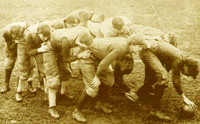

 False. Moses Fleetwood Walker, an Oberlin College star, played for one season, in 1884, with the Toledo team of the American Association, before he was forced out the following year because of racism.
False. Moses Fleetwood Walker, an Oberlin College star, played for one season, in 1884, with the Toledo team of the American Association, before he was forced out the following year because of racism. False. Robinson, although generally regarded as an excellent player, was not seen as even the best player on his team, the Kansas City Monarchs. Rickey signed him because of a combination of qualities--not only his proven and potential talent and skill at the game, but also his personal integrity and his likely strength (as Rickey saw it) at withstanding the abuse that Rickey thought Robinson would face on and off the field for breaking the color barrier in major league baseball.
False. Robinson, although generally regarded as an excellent player, was not seen as even the best player on his team, the Kansas City Monarchs. Rickey signed him because of a combination of qualities--not only his proven and potential talent and skill at the game, but also his personal integrity and his likely strength (as Rickey saw it) at withstanding the abuse that Rickey thought Robinson would face on and off the field for breaking the color barrier in major league baseball.

 Teenagers today play a central role in American culture and society. They exist not only as high school students, but as closely watched consumers and trendsetters. Yet in 1900, teenagers did not exist. There were young people in their teens, but there was no distinct teenage culture.
Teenagers today play a central role in American culture and society. They exist not only as high school students, but as closely watched consumers and trendsetters. Yet in 1900, teenagers did not exist. There were young people in their teens, but there was no distinct teenage culture.